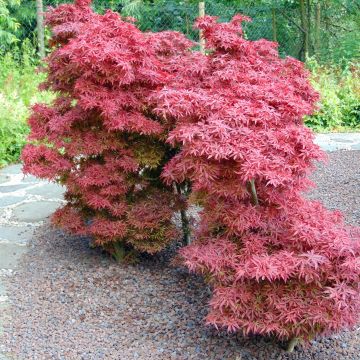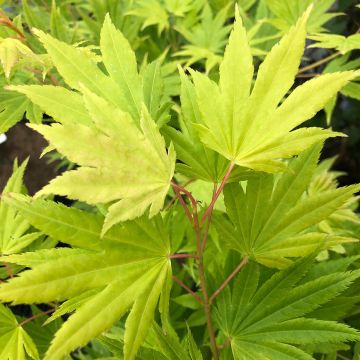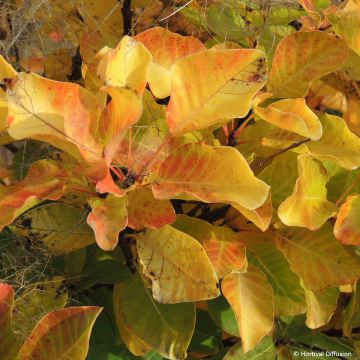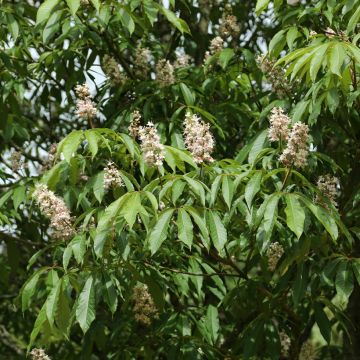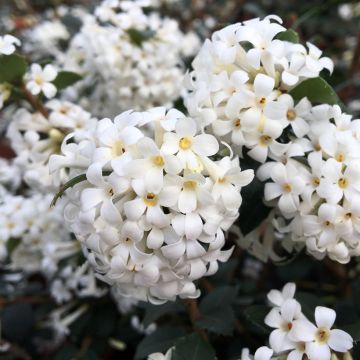

Acer rubrum Sun Valley - Maple


Acer rubrum Sun Valley - Maple
Acer rubrum Sun Valley - Maple
Acer rubrum Sun Valley
Canadian Maple, Red Maple, Virginia Maple
This item cannot be shipped to the selected country
Oversize package delivery charge from €6.90
More information
Schedule delivery date,
and select date in basket
This plant carries a 24 months recovery warranty
More information
We guarantee the quality of our plants for a full growing cycle, and will replace at our expense any plant that fails to recover under normal climatic and planting conditions.
Oversize package: home delivery by special carrier from €6.90 per order..
Express home delivery from €8.90.
Does this plant fit my garden?
Set up your Plantfit profile →
Description
This arboretum with a compact bush habit is ideal for a small garden where it can be planted alone on a short grass meadow. In a large garden, plant it alongside other trees that change colour in autumn for an "Indian summer" atmosphere. You will appreciate its deciduous foliage turning a magnificent vivid red in autumn before falling. Its melliferous spring flowering is appreciated by bees and butterflies. Cold-resistant and drought-tolerant, the 'Sun Valley' red maple is easy to grow. Its only weakness is the wind, which it does not tolerate well.
Native to the northeastern United States and Canada, the Acer rubrum or red maple is a large tree of the sapindaceae family (formerly aceraceae) that can reach 30 m (98ft) in height in its natural habitat. It grows on riverbanks, in swamps, but also in mixed forests, on less humid soils. It is particularly appreciated for its flamboyant foliage in autumn, a symbol of the Indian summer, and for its early flowering that delights bees and butterflies. The first settlers of North America used their bark to dye linen and wool in a beautiful dark blue.
The Acer rubrum 'Sun Valley', was selected for its vigorous growth and its good resistance to cicada attacks, by the US National Arboretum. It is the result of cross-breeding between Acer rubrum 'Red Sunset' and Acer rubrum 'Autumn Flame'. It is particularly appreciated for its magnificent autumn colours.
It forms a small tree with an upright habit and an oval and dense crown. It reaches a height of 6 to 10 m (20 to 33ft). Its leaves are palmatilobate and slightly jagged. Reddish when they burst, they become dark green and shiny before turning bright red in autumn. Its autumn coloration is long-lasting. Its bark is grey. The 'Sun Valley' red maple is a sterile cultivar (without fruits). It only produces male flowers. In spring, they are red, arranged in umbels and especially melliferous.
Planted alone, the 'Sun Valley' red maple is ideal for a small garden. In autumn, it will provide the decor. It is an excellent shade tree, thanks to its dense foliage. It can also be integrated into a free hedge. In a large garden, combine it with other trees with autumn colours, such as the Yellowwood (Cladastris kentukea) or the Persian Ironwood.
Flower its base with 'Major' autumn crocus or with autumn-flowering asters like Aster ageratoides Asran with lavender-blue flowers or Dwarf Aster 'Schneekissen' with white flowers.
Attention: The leaves of the red maple are highly toxic to horses.
Report an error about the product description
Plant habit
Flowering
Foliage
Botanical data
Acer
rubrum
Sun Valley
Aceraceae
Canadian Maple, Red Maple, Virginia Maple
Cultivar or hybrid
Other Acer - Maple tree
Planting and care
Plant the Acer rubrum 'Sun Valley' in full sun or partial shade in a preferably moist soil. Avoid limestone soils. Protect it from strong winds. It tolerates drought once established and can also tolerate temporary periodic flooding. Resistant to cold, it is an easy-to-care-for young tree that does not require any pruning. Do not plant the 'Sun Valley' red maple near the sea.
Planting period
Intended location
Care
-
, onOrder confirmed
Reply from on Promesse de fleurs
Striking foliage shrubs
Haven't found what you were looking for?
Hardiness is the lowest winter temperature a plant can endure without suffering serious damage or even dying. However, hardiness is affected by location (a sheltered area, such as a patio), protection (winter cover) and soil type (hardiness is improved by well-drained soil).

Photo Sharing Terms & Conditions
In order to encourage gardeners to interact and share their experiences, Promesse de fleurs offers various media enabling content to be uploaded onto its Site - in particular via the ‘Photo sharing’ module.
The User agrees to refrain from:
- Posting any content that is illegal, prejudicial, insulting, racist, inciteful to hatred, revisionist, contrary to public decency, that infringes on privacy or on the privacy rights of third parties, in particular the publicity rights of persons and goods, intellectual property rights, or the right to privacy.
- Submitting content on behalf of a third party;
- Impersonate the identity of a third party and/or publish any personal information about a third party;
In general, the User undertakes to refrain from any unethical behaviour.
All Content (in particular text, comments, files, images, photos, videos, creative works, etc.), which may be subject to property or intellectual property rights, image or other private rights, shall remain the property of the User, subject to the limited rights granted by the terms of the licence granted by Promesse de fleurs as stated below. Users are at liberty to publish or not to publish such Content on the Site, notably via the ‘Photo Sharing’ facility, and accept that this Content shall be made public and freely accessible, notably on the Internet.
Users further acknowledge, undertake to have ,and guarantee that they hold all necessary rights and permissions to publish such material on the Site, in particular with regard to the legislation in force pertaining to any privacy, property, intellectual property, image, or contractual rights, or rights of any other nature. By publishing such Content on the Site, Users acknowledge accepting full liability as publishers of the Content within the meaning of the law, and grant Promesse de fleurs, free of charge, an inclusive, worldwide licence for the said Content for the entire duration of its publication, including all reproduction, representation, up/downloading, displaying, performing, transmission, and storage rights.
Users also grant permission for their name to be linked to the Content and accept that this link may not always be made available.
By engaging in posting material, Users consent to their Content becoming automatically accessible on the Internet, in particular on other sites and/or blogs and/or web pages of the Promesse de fleurs site, including in particular social pages and the Promesse de fleurs catalogue.
Users may secure the removal of entrusted content free of charge by issuing a simple request via our contact form.
The flowering period indicated on our website applies to countries and regions located in USDA zone 8 (France, the United Kingdom, Ireland, the Netherlands, etc.)
It will vary according to where you live:
- In zones 9 to 10 (Italy, Spain, Greece, etc.), flowering will occur about 2 to 4 weeks earlier.
- In zones 6 to 7 (Germany, Poland, Slovenia, and lower mountainous regions), flowering will be delayed by 2 to 3 weeks.
- In zone 5 (Central Europe, Scandinavia), blooming will be delayed by 3 to 5 weeks.
In temperate climates, pruning of spring-flowering shrubs (forsythia, spireas, etc.) should be done just after flowering.
Pruning of summer-flowering shrubs (Indian Lilac, Perovskia, etc.) can be done in winter or spring.
In cold regions as well as with frost-sensitive plants, avoid pruning too early when severe frosts may still occur.
The planting period indicated on our website applies to countries and regions located in USDA zone 8 (France, United Kingdom, Ireland, Netherlands).
It will vary according to where you live:
- In Mediterranean zones (Marseille, Madrid, Milan, etc.), autumn and winter are the best planting periods.
- In continental zones (Strasbourg, Munich, Vienna, etc.), delay planting by 2 to 3 weeks in spring and bring it forward by 2 to 4 weeks in autumn.
- In mountainous regions (the Alps, Pyrenees, Carpathians, etc.), it is best to plant in late spring (May-June) or late summer (August-September).
The harvesting period indicated on our website applies to countries and regions in USDA zone 8 (France, England, Ireland, the Netherlands).
In colder areas (Scandinavia, Poland, Austria...) fruit and vegetable harvests are likely to be delayed by 3-4 weeks.
In warmer areas (Italy, Spain, Greece, etc.), harvesting will probably take place earlier, depending on weather conditions.
The sowing periods indicated on our website apply to countries and regions within USDA Zone 8 (France, UK, Ireland, Netherlands).
In colder areas (Scandinavia, Poland, Austria...), delay any outdoor sowing by 3-4 weeks, or sow under glass.
In warmer climes (Italy, Spain, Greece, etc.), bring outdoor sowing forward by a few weeks.

































